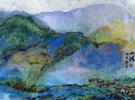Topographies of the Self
Raul Zamudio
Topographies of the Self is a solo exhibition of the painter Sun Yao, whose title alludes to the symbiosis between landscape and identity. Geography has been historically thought to be untainted, objective and generally outside the bounds of culture; for in one sense we are born into culture as opposed to nature. This, however, is erroneous: not only is place tied to our sense of self, but in our globalized milieu any environment be it country or city, for instance, can transcend its geography by virtue of its inhabitants who bring an aspect of that locale to far flung areas of the world. For example: A Spanish vintner or a New York businessman embody aspects of their culture as well as their geography, regardless whether one is rural and the other urban which, in turn, is the social baggage they pack and unpack when travelling abroad. This, of course, becomes even more complicated since culture and place are more often than not heterogeneous rather than monolithic as attested by the protean nature of the local engendered by communications and computer technologies such as the Internet.
With the advent of globalization in which disparate geographies and cultures become more and more accessible, the fabric of the geo-cultural is ever changing, in flux, and analogous to the postmodern condition of the self. That is, that it is not something deterministic, essential, or fixed, but fluid, mutable and open-ended. Topographies of the Self is an exhibition that is more than an exploration of the symbiosis between self and place as it investigates how deeply the individual and the collective are linked and at the same time severed, from their environments. It explores this through myriad ideas including the sublime, the contingency of the self, and the thesis that nature is anything but natural.
Sun Yao’s paintings underscore how the world we inhabit is intrinsically connected to our psyche, much like other artists who have explored landscape’s affectation. The German Romantic artist Casper David Friedrich, for example, depicted nature as sublime, albeit as embodied with the metaphysical. Another artist who came in the wake of Friedrich and conceived sublimity differently is the British painter J.W.M. Turner. Both artists differed in their articulation of the sublime; the former configured it as extension and manifestation of the transcendent, while the latter interpreted it as an extension of the moral absolute. Regardless, Friedrich’s and Turner’s idea of sublimity can be traced to the philosopher Edmund Burke. In A Philosophical Enquiry into the Origin of Our Ideas of the Sublime and Beautiful (1756), Burke proposed that beauty and the sublime were mutually exclusive, but yet paradoxically connected. The sublime, for Burke, was as much about being awed by nature’s beauty as it was about the fear engendered by its uncontrollable violence in which humans are seemingly at its mercy.
The dichotomy of the sublime where one aspect refers to the majestic while the other embodies terror is underscored in any horrendous natural disaster; and though we regret and are despondent when humans perish as a result of natural calamities, we are often mesmerized by images of destruction and the havoc that it can cause to life as well as the built environment. One only need to see on Youtube the many viewer’s hits of filmed tsunamis, volcanoes, hurricanes, earthquakes and so forth to understand how the human mind is repulsed and concomitantly attracted to nature’s terrifying destructive powers. An ostensible universal coping mechanism in the face of the absurdity of nature’s infliction of mass death is when we construe it as an “act of god.” That is, that nature’s brutal violence resulting in the wanton loss of life is so inexplicable and so unfathomable that it is attributed to providence. Burke would argue, however, that it is not a case of humans being morbid or insensitive to the loss of human life that keeps us from watching images of destruction, but that the dichotomy of repulsion/attraction as sublime is analogous to human faculty for the aesthetic; that the recognition of the beautiful as intrinsic to human consciousness is also what makes it difficult for us to turn our eyes away from nature’s upending aggression. This is crucial in understanding how sublimity works in the paintings of Friedrich and Turner, and intrinsic to the mesmerizing artistry of Sun Yao.
The powerful and poetic quality of Sun Yao’s work partially stems from a reworking of the landscape tradition into wholly different configurations. This is apparent when juxtaposing Friedrich’s The Monk by the Sea (1808-1810), and Sun Yao’s N0. 15 (Series: Deep Forest) (2010). While the latter is part of the corpus known as Deep Forest and generally concerns various interpretations of the confluence of flora and the human body, this painting alludes to the aquatic as well as terrestrial. This may have to do with Sun Yao’s handling of paint and his hypnotic use of chiaroscuro: pigment swirls to and fro and explodes like chaotic arabesques across the surface of his paintings and within pictorial space. And the execution of this painterly exuberance runs the gamut of thin, almost diffused simulated washes to heavy graphic marks as well as thicker passages of impasto. There is also the monumental format of Sun Yao’s paintings in general that create a similar ambiance to The Monk by the Sea.
In Friedrich’s famous work, a monk stands at the shore of the sea while solemnly pondering divinity and looking out into its glorious yet gothic infinitude. The enveloping presence of the sea that engulfs the monk is analogous to how Sun Yao creates anthropomorphic forms that congeal against the amorphousness of trees making it difficult to tell where one supersedes the other. Are the individuals that populate the landscape more prominent or subservient to the latter? In creating an either/or aesthetic conundrum, Sun Yao inscribes this painting with meaning beyond than what meets the eye: phantasmagoria of spirit-like entities pulsate and animate the picture as if we are glimpsing a fleeting magic lantern of projections conjured from the deep recesses of the unconscious. To be sure, we are looking at a painting yet there is something underneath and within it that both beckon us as well as creating a sensation of aesthetic dissipation. Like Sun Yao, Turner too, developed a particular notion of the sublime but his work was often imbued with an ethical if not moral imperative.
In Turner’s Slave Ship (1840), which is one of the most famous works by the English painter, traffickers in human cargo are horrifically meeting their demise by virtue of an uncontrollable sea storm. But this work is not just the nineteenth-century equivalent to what is known in Hollywood as the disaster film. To be sure, what is occurring in the picture is what the painting’s title alludes. Turner, however, is depicting something more than just the dreadful fate of a ship at the mercy of tumultuous weather; for it is also the institution of slavery that is being destroyed, not so much by the pristine sea but by divine retribution that condemns that enslavement of a human by another. It is apparent that Sun’s picture is a metaphor for the human condition as well, for he conveys to us the drama of what it is to deal with existential questions of as to our rightful place in a world where we are sometimes in conflict with nature, but also even at odds with ourselves.










